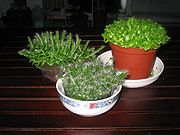
Hylocereus
Encyclopedia

Genus
In biology, a genus is a low-level taxonomic rank used in the biological classification of living and fossil organisms, which is an example of definition by genus and differentia...
of cacti
Cactus
A cactus is a member of the plant family Cactaceae. Their distinctive appearance is a result of adaptations to conserve water in dry and/or hot environments. In most species, the stem has evolved to become photosynthetic and succulent, while the leaves have evolved into spines...
, often referred to as nightblooming cactus
Nightblooming cactus
The term nightblooming cactus refers to either of these two cacti genera:*Hylocereus*Selenicereus, or moonlight cactiSee also nightblooming cereus....
(though the term is also used for the genus Selenicereus). Several species
Species
In biology, a species is one of the basic units of biological classification and a taxonomic rank. A species is often defined as a group of organisms capable of interbreeding and producing fertile offspring. While in many cases this definition is adequate, more precise or differing measures are...
have large edible fruit
Fruit
In broad terms, a fruit is a structure of a plant that contains its seeds.The term has different meanings dependent on context. In non-technical usage, such as food preparation, fruit normally means the fleshy seed-associated structures of certain plants that are sweet and edible in the raw state,...
s, which are known as pitaya
Pitaya
A pitaya or pitahaya is the fruit of several cactus species, most importantly of the genus Hylocereus . These fruits are commonly known as dragon fruit – cf...
or dragonfruits.
Taxonomy
A difficult genus with poorly understood species, due to their wide range and variability. Closely related to Selenicereus.The genus Wilmattea Britton
Nathaniel Lord Britton
Nathaniel Lord Britton was an American botanist and taxonomist who founded the New York Botanical Garden in the Bronx, New York. Britton was born in New Dorp in Staten Island, New York...
& Rose
Joseph Nelson Rose
Joseph Nelson Rose was an American botanist. He was born in Union County, Indiana. His father died serving during the Civil War when Joseph Rose was a young boy. He later graduated from high school in Liberty, Indiana....
has been brought into synonymy with Hylocereus. Besides, some would include Hylocereus in the genus Selenicereus.
Summary of the species
- Hylocereus calcaratus - Costa Rica. Stems soft, green with distinctly lobed stems. Flowers 35–37 cm long, 20–30 cm wide.
- Hylocereus costaricensisHylocereus costaricensisHylocereus costaricensis, the Costa Rica Pitahaya, is a cactus species native to Central America and northwestern South America. The species is grown commercially for its Pitaya fruit, but is also an impressive ornamental vine with huge flowers. Most plants grown under the name Hylocereus...
- (incl Hylocereus polyrhizus of gardens) Costa Rica and Nicaragua to Peru. Stems waxy-white without horny margins. Flowers ca. 30 cm long with large bracts, usually with purple margins. Fruit red with purple pulpa. - Hylocereus escuintlensis Guatemala. Stems green not glaucous, brown-margined. Flowers 28–31 cm long, 24–36 cm wide.
- Hylocereus megalanthusHylocereus megalanthusHylocereus megalanthus is a cactus species native to northern South America, where it is known, along with its fruit, by the name of Pitahaya. The species is grown commercially for its fruit, but is also an impressive ornamental vine with perhaps the largest flowers of all...
- Stems green, slender without horny margins. Flowers 30–38 cm long with large flattened tubercles and small bracts. Flowers similar to Selenicereus. Fruit yellow. - Hylocereus minutiflorus - Guatemala, Honduras. Stems green. Flowers with rigid spines at base of flower, 5 cm long, 8–9 cm wide, white.
- Hylocereus monacanthus - (incl. Hylocereus lemairei) Costa Rica to N South America. Stems gray-green without horny margins. Flowers ca 30 cm long, petals white, tinged pinkish near base or entirely pink. Tube with distant bracts. Stigma lobes usually forked. Fruit red with purple pulpa.
- Hylocereus ocamponis - (incl. Hylocereus guatemalense, Hylocereus purpursii) Mexico & Guatemala. Stems white-waxy, margins horny, spines needle-like, to 12 mm long. Flowers 25–32 cm long with white inner petals. Bracts overlapping, with purple margins.
- Hylocereus setaceusHylocereus setaceusHylocereus setaceus is a species of plant in the Cactaceae family. It is found in Argentina, Bolivia, Brazil, and Paraguay. Its natural habitats are subtropical or tropical dry forests, subtropical or tropical moist lowland forests, rocky shores, and sandy shores. It is threatened by habitat...
- Stems green without horny margins, rather spiny. Flowers 19–22 cm with small tubercles and bracts. Flowers similar to Selenicereus. Fruit red. - Hylocereus stenopterus- Costa Rica. Stems thin, soft, green. Flowers 9–10 cm long, 13–15 cm wide, tube short, tepals purplish red.
- Hylocereus triangularis (incl. Hylocereus cubensis). Cuba, Haiti, Dominican Republic, Jamaica. Stems green without horny margins, slender. Flowers ca. 20 cm long, base with wide overlapping scales.
- Hylocereus trigonus - (incl. Hylocereus napoleonis, Hylocereus antiguensis). West Indies (Puerto Rico south to Grenada). Stems green without horny margins. Flowers ca. 22 cm long, 21 cm wide, base with small, narrow, widely spaced scales, sometimes spiny. Fruit red.
- Hylocereus undatusHylocereus undatusHylocereus undatus is a species of Cactaceae and is the most cultivated species in the genus. It is used both as an ornamental vine and as a fruit crop - the Pitaya or Dragonfruit...
Native habitat unknown and maybe of hybrid origin. Stems green, margins undulate and horny. Flowers 25–30 cm long, white with green outer tepals and bracts. Fruit red with white pulpa.
See also
- EpiphyllumEpiphyllumEpiphyllum is a genus of 19 species of epiphytic plants in the cactus family , native to Central America. Common names for these species include orchid cacti and leaf cacti, though the latter also refers to the genus Pereskia....
- another cactus genus yielding edible fruits

